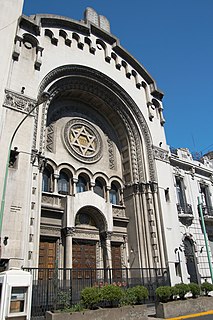Related Research Articles

Aliyah is the immigration of Jews from the diaspora to the Land of Israel historically, which today includes the modern State of Israel. Also defined as "the act of going up"—that is, towards Jerusalem—"making aliyah" by moving to the Land of Israel is one of the most basic tenets of Zionism. The opposite action, emigration from the "Land of Israel", is referred to in Hebrew as yerida ("descent"). The State of Israel's Law of Return gives Jews, their children, and their grandchildren automatic rights regarding residency and Israeli citizenship.

Argentina, for much of its history and including the present day, has been an overwhelmingly Christian country. The largest Christian denomination in the country is Roman Catholicism. The historical background is very much due to the Spanish influence brought about through the newly conquered territories. However, immigration throughout the 20th century has brought other Catholics and denominations from various regions to Argentina.
Yerida is emigration by Israeli Jews from the State of Israel. Yerida is the opposite of aliyah, which is immigration to Israel. Zionists are generally critical of the act of yerida and the term is somewhat derogatory. The emigration of non-Jewish Israelis is not included in the term "Yerida".

Immigration to Argentina began in several millennia BC with the arrival of cultures from Asia to the Americas through Beringia, according to the most accepted theories, and were slowly populating the American continent. Upon arrival of the Spaniards, the inhabitants of Argentine territory were approximately 300,000 people belonging to many civilizations, cultures and tribes.

The history of the Jews in Argentina goes back to the early sixteenth century, following the Jewish expulsion from Spain. Sephardi Jews fleeing persecution immigrated with explorers and colonists to settle in what is now Argentina. In addition, many of the Portuguese traders in the Viceroyalty of the Río de la Plata were Jewish. An organized Jewish community, however, did not develop until after Argentina gained independence from Spain in 1816. By mid-century, Jews from France and other parts of Western Europe, fleeing the social and economic disruptions of revolutions, began to settle in Argentina.
Argentine Americans are Americans whose full or partial origin is in Argentina.

In the wake of the 1999–2002 Argentine political and economic crisis, many Argentine Jews emigrated to Israel. The 1992 attack on the Israeli embassy and the 1994 bombing of the Jewish Community Center in Buenos Aires also helped create an impetus for Jews to emigrate.
Koreans in Argentina form the second-largest Korean diaspora community in South America and the 16th largest in the world, according to the statistics of South Korea's Ministry of Foreign Affairs and Trade. Their population declined by more than 50% between 1997 and 2003. Despite the small rebound in their numbers since then, they have been surpassed in size by the rapidly growing Chinese Argentine community. In the 2010s decade, the Korean community in Argentina has fallen behind Korean communities in Australia, New Zealand, the United Kingdom, the United States, Brazil, Canada, Singapore, The United Arab Emirates and Southeast Asia.
In Argentina, there are and have been cases of discrimination based on ethnic characteristics or national origin. In turn, racial discrimination tends to be closely related to discriminatory behavior for socio-economic and political reasons.
French Argentines refers to Argentine citizens of full or partial French ancestry or persons born in France who reside in Argentina. French Argentines form one of the largest ancestry groups after Italian Argentines and Spanish Argentines. Between 1857 and 1946, 261,020 French people immigrated to Argentina. Besides immigration from continental France, Argentina also received, as early as the 1840s, immigrants with French background from neighboring countries, notably Uruguay, which expanded the French Argentine community. In 2006, it was estimated that around 6 million Argentines had some degree of French ancestry, up to 17% of the total population.
Russian Argentines are people from Russia living in Argentina, and their Argentine-born descendants. The estimates of the number of Argentines of Russian descent vary between 170,000 and 350,000. They are mostly living in Buenos Aires and Greater Buenos Aires.

Austrian Argentines are Argentine citizens of Austrian descent or Austrian-born people who emigrated to Argentina. Many Austrian descendants in Argentina arrived in the country from other parts of Europe when Austria was a unified kingdom with Hungary.

Argentines are people identified with the country of Argentina. This connection may be residential, legal, historical or cultural. For most Argentines, several of these connections exist and are collectively the source of their being Argentine.

International relations between Argentina and Israel, have existed for decades. Both countries established diplomatic relations on May 31, 1949.
European Argentines belong to several communities which trace their origins to various migrations from Europe and which have contributed to the country's cultural and demographic variety. They are the descendants of colonists from Spain during the colonial period prior to 1810, or in the majority of cases, of Spanish, Italians, German and other Europeans who arrived in the great immigration wave from the mid 19th to the mid 20th centuries, and who largely intermarried among their many nationalities during and after this wave. No recent Argentine census has included comprehensive questions on ethnicity, although numerous studies have determined that European Argentinians have been a majority in the country since 1914.
There is a significant Argentine diaspora in Mexico. According to the 2010 census, there were 13,696 registered Argentine citizens living in Mexico, an increase from the 6,465 registered in the 2000 census. Argentine immigrants constitute the second largest community of South Americans in Mexico and the fifth largest immigrant community overall.
Bolivian Argentines are Argentine citizens of Bolivian descent or Bolivia-born people who emigrated to Argentina. In recent decades, Bolivia has become one of the main sources of immigration in Argentina, making Bolivians one of the largest Hispanic American immigrant groups in Argentina, along with Paraguayans and Peruvians.

Argentines in Spain are the largest community of Argentines abroad. In Spain, they form one of the largest immigrant groups in the country.
Dutch Argentines are Argentine citizens of full or partial Dutch ancestry or people who emigrated from the Netherlands and reside in Argentina. Dutch immigration to Argentina has been one of many migration flows from Europe in that country, although it has not been as numerous as in other cases. However, Argentina received a large contingent of Dutch since 1825. The largest community is in the city of Tres Arroyos in the south of the province of Buenos Aires.

The history of the Jews in Paraguay begins with the arrival of migration flows, mainly from Europe. The first waves of Jewish immigration to Paraguay began in 1904.
References
- ↑ Para ti. "Argentinos en Israel" (in Spanish). Archived from the original on 2016-04-23. Retrieved 2014-03-20.
- ↑ LeElef, Ner. "World Jewish Population" . Retrieved 2008-01-09.
- ↑ Para ti. "Argentinos en Israel" (in Spanish). Archived from the original on 2016-04-23. Retrieved 2014-03-20.
- ↑ Roth, Cecil (ed.). Encyclopaedia Judaica (1972), Volume 3, p. 426.
- ↑ "Jews targeted in Argentina's dirty war". The Guardian. 1999.
- ↑ Prensa Judía. "Los judíos argentinos son los que más emigran a Israel" (in Spanish). Archived from the original on 15 January 2014. Retrieved 13 January 2014.
- ↑ Perfil Migratorio de Argentina (PDF) (in Spanish). Buenos Aires: Organización Internacional para las Migraciones. 2012. p. 184. ISBN 978-92-9068-657-6 . Retrieved 2 March 2013.